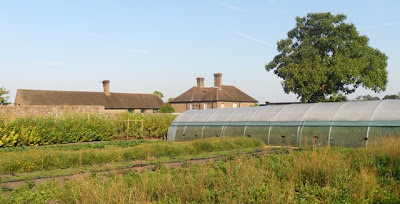Sprinter and sprummer in the UK?
Today was a gorgeous autumnal, or perhaps summeral, day in London. Puffs of warm wind, 25 degrees C, and another crop of berries on my backyard brambles.
Of course the mind turns to seasons. In Australia I lobbied (rather unsuccessfully it has to be said) for a shift from a colonial perspective to a more indigenous one, or at least one informed by living and observing in the country. I argued a change from four to my five seasons would be seen as radical and a break with our European traditions.
Now that I've arrived at the source, so to speak, I've found at least a little dissent. In 1954 renowned UK meteorologist Hubert H. Lamb wrote the charmingly titled The English Climate. In the second edition (1964) Lamb was at pains to explain that the book was about the weather and climate of all of the United Kingdom, not just England. More radical than treating England as part of a greater Britain was his ‘division of the year into five broad natural seasons and the finer division represented by the singularity calendar’. Yes, five seasons! For the UK!
Lamb is approaching this from a climate or weather perspective, not from my biological angle, but it’s intriguing to see how the two systems match, to some extent. His starting point is the tendency for weather to occur in relatively long spells on a more or less regular basis. You’ll notice the abundance of qualifying words in there and I’m sure Hubert Lamb would want me to include these. A ‘long spell’ for Lamb was a particular type of weather persisting for more than 25 days (with allowance for up to 3 days of minor interruption by some passing weather phase).
Across the British Isles, between 1898 and 1947, Lamb identifies 158 long spells in weather combining wind direction (e.g. Easterly) and whether Cyclonic or Anticyclonic. These, he says, match ‘famous spells’ such as droughts or severe cold or wet periods. Lamb then plots these against day of the year and decides the pattern, along with further evidence and experience, leads him to identify five seasons, with possible further subdivision as I’ll get to shortly.
As an example, he says ‘weather settles down into a long spell of one kind or other at some time during July-August [late summer] in about 70% of the years studied’, and similarly for autumn. He notes that ‘it is not surprising…that the natural seasons marked out by these habits of the atmospheric circulation awkwardly fail to agree with any of the neat conventions for dividing the year up into four seasons of equal length…’. Indeed!
Lamb comes up with names for his five seasons – not particularly poetic and a little more conservative than my own, but certainly practical. There are similarities with my Australian seasons, and I’ve indicated in brackets the rough correlation:
Late Winter & Early Spring 20 Jan-31 Mar (Sprinter: 1 Feb-31 Mar)
Spring & Early Summer 1 Apr-17 Jun (Sprummer: 1 Apr-30 May)
High Summer 18 Jun-9 Sep (Summer: 1 Jun to 31 Sep)
Autumn 10 Sep-19 Nov (Autumn: 1 Oct-30 Nov)
Early Winter 20 Nov-19 Jan (Winter: 1 Dec-31 Jan)
The main difference is my desire to reflect the long, four-month ‘summer’ in Australia, eating into autumn, which not surprisingly is not such a feature in the UK. I should add that even within this narrower summer window, Lamb found during his 50 year period of study that long spells occurred in seven years of each decade but wet cyclonic spells were twice as numerous as ‘persistently anticyclonic’ ones (which I take to be fine, warm summers). And more often than either, were westerly/north-westerly dominated spells with alternations of ‘bright and disturbed days’. The UK summer is clearly a slippery beast.
Hubert Lamb felt there was ever further resolution possible, and introduced what he calls singularities into the equation. Singularities are things events that occur (add qualifiers…) more or less around the same time each year. Lamb cites various historical examples of days that were said to signify changes in weather patterns, such as St John’s Day (‘before St John’s Day [24 June] we pray for rain, after that we get it without praying’ is cited) or St Smithen’s Day (‘if it rains on that day (15 July) it will rain for 40 days thereafter (until 24 August)’).
Some of these days and sayings are supported by observations, others not. There is evidence of patterns that are more likely than others at particular times of the year, but fairly predictably, not tied down to a single date. Lamb presents a thorough analysis of the ‘singularity phenomenon’ and then peppers his seasonally classification with what we might call subseasons based on frequently occurring weather patterns, with their percentage likelihood of occurring based on the 50-year study.
This results in 13 subseasons, with fairly complex definitions, and far more complex than I think most people would want. Still I do like some of the alternative names suggested such as ‘Golden Leaves’. This applies to the Early October Anticyclones between 2 and 8 October, which in 40% of years gives you anticyclonic, southerly or easterly spells, and 40% of the year westerlies. ‘Fall of the Leaves’ is the Late Autumn Rains stormy period, which brings spells other than anticyclones between 24 and 31 October in 80% of years (or 90% for some of these days). And so on, but generally even more prosaically.
The key point here is that I am not alone in thinking that four seasons is a bit arbitrary and that even in the ‘home’ of the Vivaldi option, there is dissent.
Image: the nursery at Wakehurst Place in the last week of August

Comments
What about the 12 of Japan - 4 seasons divided into early, middle and late.
http://en.wikipedia.org/wiki/Kigo
Tim